This is a Veteran Owned site

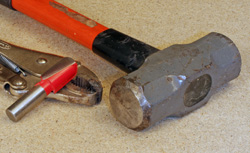 |
If a stuck bit frustrates you to the point pry bars and hammers come to mind, it's time for a break - and more rational thinking! Click image to enlarge |
Self-Releasing Router Collets
When stuck bits aren't stuck
Text, photos and video by Tom Hintz
Updated - 9-24-2011
Over the last several years, router manufacturers developed self-releasing router collets in an attempt to end the problem of stuck bits. To a large degree, the new collets have done just that. It remains possible to have a bit hang up in the collet but those instances are far less common.
An unintentional problem caused by self-releasing collets is faking out new router owners, most of whom had not read the instruction manual. NewWoodworker.com receives several emails per week asking how to get a stuck bit out of a self-releasing collet and usually, the answer is simply finishing the release process.
How Self-Releasing Collets Work
It is important to know that the collet nut does not clamp the fingers around the bit shaft. Rather, the collet nut forces the inner collet finger piece (and the bit) into a taper in the shaft of the router. It is that taper that applies the inward force on the collet fingers, generating the grip on the bit.
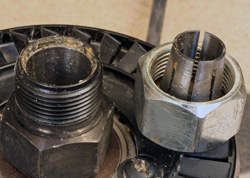 |
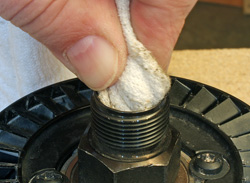 |
The self-release collets are very common today (left) but you have to keep them clean if you expect them to work right. I clean my collets often but this is the grunge that built up after just a couple days of use. I never use anything harder than an old sock (right) to clean out the taper in the router spindle. The cloth does a great job and will not harm that taper. Click images to enlarge |
|
Self-releasing collets have a mechanical connection between the collet nut and the inner finger assembly. When the collet nut is loosened, it turns free until it begins pulling on the inner finger assembly. At that point, the nut feels like it tightened up again. Using the wrenches, continuing to turn the nut off pulls the inner finger piece out of the taper in the router shaft and releases its grip on the bit.
It is this "free state" between loosening the nut and encountering the second level of resistance that makes some think the bit should be free. In most cases, reading the instructions would have clarified the process. I realize that some instruction sheets can be difficult to understand and may contribute to this confusion.
Nothing Is Perfect
Despite the new thinking in router collets, it remains possible to hang a bit up in them. Those instances are rare considering the number of times the bit releases as designed, but they can hang up, especially with a little help from the operator.
Like any machine, keeping the router collet clean is important. Removing it from the router completely and getting all the built up dust from inside and around the fingers should be a part of normal maintenance. If dust builds up in the wrong place, it can be compressed and cause uneven pressure that can wedge the collet parts into a position that can result in a stuck bit that can be difficult to extract.
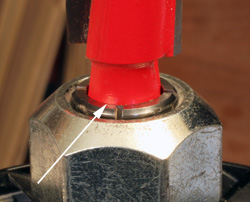 |
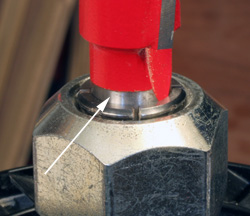 |
You can set some bits all of the way into the collet (left) until they bottom out but that can cause them to get stuck, occasionally in self-release collets. If you raise the bit just an 1/8" or so (right) that problem is eliminated. |
|
The Big No-No
Probably the most common mistake made by woodworkers is seating the bit fully in the collet when installing it. With the end of the bit shaft against the bottom of the collet, the fingers that grip it can be put into a tension that makes it very difficult for them to release. To allow the self-releasing collet mechanism to work as designed we need a small amount of clearance between the end of the bits shaft and the bottom of the collet.
Some install a small rubber o-ring that closely fits the inside diameter of the collet. Pushing this o-ring to the bottom of the collet prevents the bit from going down that far. Since the rubber can compress, the self-releasing mechanism can still function.
More common is inserting the bit until it bottoms out and then lifting it 1/16" to 1/8" before tightening the nut. With most of the modern collets, the bit can be held just off the bottom and the nut tightened by hand enough to hold the bit while the wrenches are applied to fully tighten the collet.
When It Really Is Stuck
On the rare occasions that a bit actually is stuck in the collet, caution is required when trying to free it. Prying up on the bit using some kind of lever between it and the router case may sound like a good idea but can easily damage the router, especially the bearings.
One method I have found to work is holding the router shaft with the wrench, wrap several layers of a heavy rag around the bit to protect your fingers from the cutting edges and apply a twisting motion, alternating directions. In many cases, that is all that is needed to break the bit free.
Last Resorts
Video Tutor |
When all else fails, people tend to get physical with a stuck bit. It is important to know that using virtually any kind of lever or hammer-type force can damage the bit and/or router in ways that may not be evident right away. It should be obvious that any kind of damage to a bit or router can become dangerous at some point during future use.
If you get to the twisting method and still cannot free the bit, I would suggest contacting the bit or router manufacturer for suggestions. Taking the time to obtain qualified advice will keep you and your equipment safer.
Have a comment on this story? - Email Me!
Back to the Tips & Tricks List
All written, photographic and drawn materials are property of and copyright by NewWoodworker.com LLC 2000-2019. Materials may not be used in any way without the written permission of the owner.
